44+ Serial Killer Movies
From the quiet murders that go under the radar to the bombastic slayings of scores of victims, these serial killer movies highlight the worst humanity has to offer.
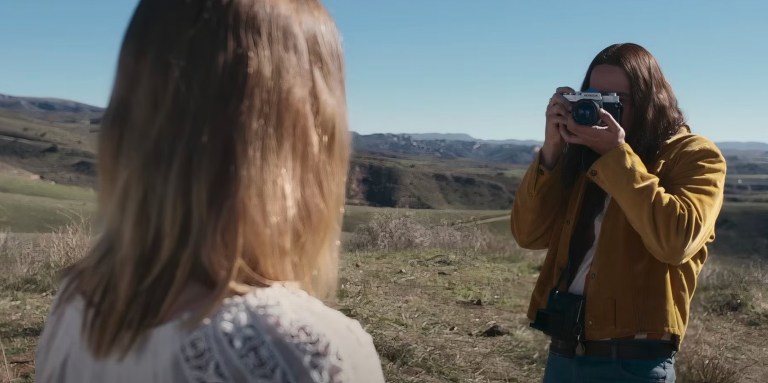
Table of Contents
The FBI defines a “serial killer” as someone who murders three or more people during three different incidents—they kill in a series, hence the word “serial,” rather than all at once, which would make them a “mass murderer” instead. According to estimates, there are around 2,000 serial killers currently operating in the United States.
That’s a terrifying notion, isn’t it? As you read this, 2,000 severely damaged people, most of them men, are dispatching bodies undetected. There’s something so unsettling about the very notion of someone who’s so alienated and lives such a loveless life that they take to murdering people one by one. But it’s the very discomfort with the idea of such ghouls that have made serial killers an unfortunate fixture in American pop culture.
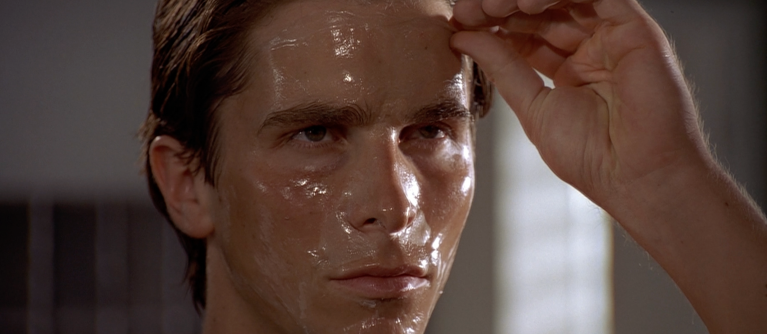
Most, but not all, of the following films are based on real-life serial killers. Most of them take quite a bit of artistic license with their origin stories. But all of them attempt, successfully or not, to understand the psychological dynamics that would impel someone to start randomly murdering others.
Best Serial Killer Movies
The Night of the Hunter (1955)
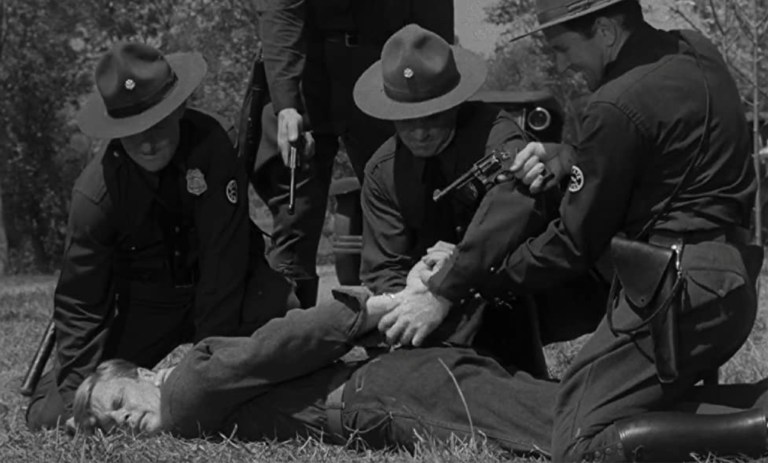
Legendary Hollywood actor Robert Mitchum burns up the screen in director Charles Laughton’s cautionary tale about an itinerant “preacher” named Harry Powell who hides his serial killing behind the Gospel as he preys upon weak and vulnerable women in a small West Virginia town during the Great Depression. The most iconic image from the film is of the words LOVE and HATE that Powell has tattooed on the knuckles of his hands. Powell’s character is based on a real-life serial killer named Harry Powers. Paste writes, “Reverend Harry Powell is quite the villain, a man as quick to distort the truth with honey-coated lies as Laughton is to distort reality through oblique perspective, unnerving use of shadows and light, and a dizzying array of camera compositions that make small-town West Virginia feel altogether otherworldly.”
The Bad Seed (1956)
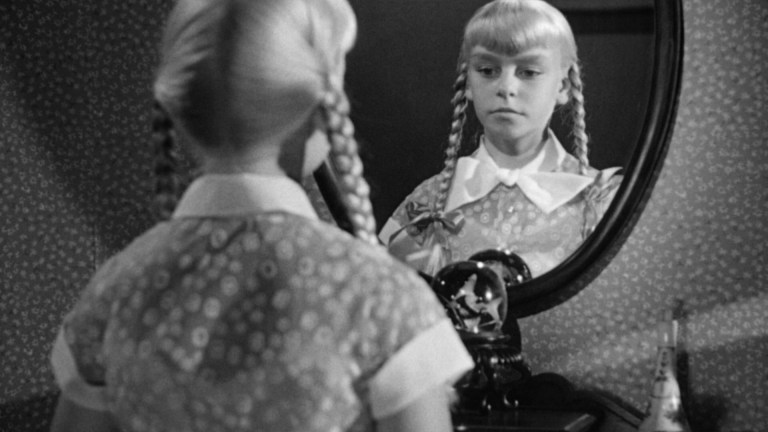
Patty McCormack was only 11 years old when she shocked America with her portrayal of little eight-year-old Rhoda Penmark, a girl who knows exactly what she wants and isn’t afraid to ask for it—and isn’t afraid to seize it if it isn’t immediately handed over to her. When her father, Colonel Kenneth Penmark, is sent off on a military mission in Washington, DC, her mother Christine slowly realizes to her horror that her little girl is a serial killer responsible for a string of local murders. But Rhoda is a malevolent force of nature, and even her mother’s attempt to kill her with an overdose of sleeping pills winds up backfiring. Paste writes, “The menace and sheer, unflinching look into human cruelty in The Bad Seed is truly unique for its time period, with young McCormack’s performance ranking among the all-time greats for children in a horror film. The Bad Seed is about the horrors of responsibility as a parent, when there’s something you know needs to be done but the act of carrying it out is something the world will never be able to understand.”
Peeping Tom (1960)
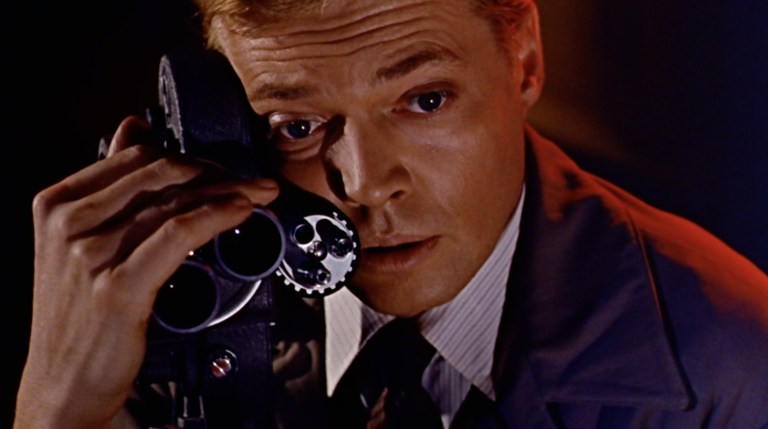
Released only three months before Alfred Hitchcock’s game-changing Psycho, Michael Powell’s meticulously terrifying portrait of a psychotic photographer was quickly censored in England and blamed for ruining Powell’s career. Although considered tawdry and trashy upon its release, it gradually gained status as a cult classic. Martin Scorsese admired Powell’s film so much that he said there were only two films that any aspiring director needed to watch—Federico Fellini’s 8-1/2 and Michael Powell’s Peeping Tom. Mark Lewis (Carl Boehm) is a tortured photographer who has a camera tripod with a knife embedded in it. He enjoys filming women’s expressions as he’s stabbing them to death and they realize they’re about to die. Esquire called it “a provocative, seedy, brooding piece that asks uncomfortable questions about voyeurism and cinema.”
Psycho (1960)

Considered the first modern horror movie and featuring what is considered to be the most-watched sequence in film history—the brutal stabbing murder of Janet Leigh in the shower—Alfred Hitchcock’s Psycho was based on the Robert Bloch novel of the same name. A secretary from Phoenix, AZ (Janet Leigh) embezzles $40,000 from her employer’s client and then goes on the lam, driving toward northern California. When a rainstorm strands her at a remote lodging facility called the Bates Motel, she meets proprietor Norman Bates (Anthony Perkins), an intense young man with severe mommy issues. Bucking horror-movie tradition, the female lead gets murdered only about a third of the way into the film. The rest of the story involves Norman’s attempts to evade justice for his multiple crimes. Noting the film’s tremendous impact, Time Out writes, “It’s spawned innumerable imitators and parodies, some subpar sequels, a TV spinoff, a biopic, a documentary and a shot-for-shot remake. If there’s anything ‘new’ to say about Psycho, perhaps it’s that the movie’s far-reaching impact has come to obscure the Anthony Perkins performance at the centre–it’s impossible to imagine anyone else as Norman Bates, and the film casting such a long shadow without him.”
The Honeymoon Killers (1969)
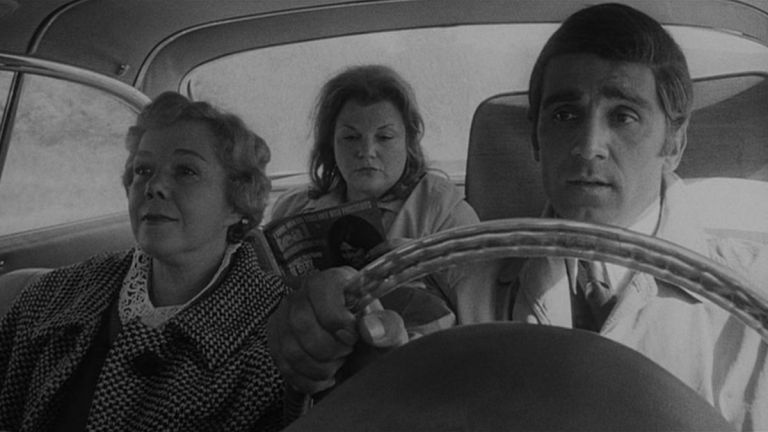
This grimly dark low-budget black-and-white film by Leonard Kastle—his only film—is based on the gruesome story of Raymond Fernandez and Martha Beck, AKA “The Lonely Hearts Killers.” Raymond was a self-styled Latin lover and Martha was a disgruntled and severely overweight nurse. The two became pen pals through a dating service and teamed together to lure other women into their web, divesting them of their valuables and murdering them before quickly moving onto the next victim. Tony Lo Bianco plays Fernandez and Shirley Stoler portrays Martha Beck in an oddly heartbreaking story of murder, betrayal, and romantic vengeance.
Badlands (1973)
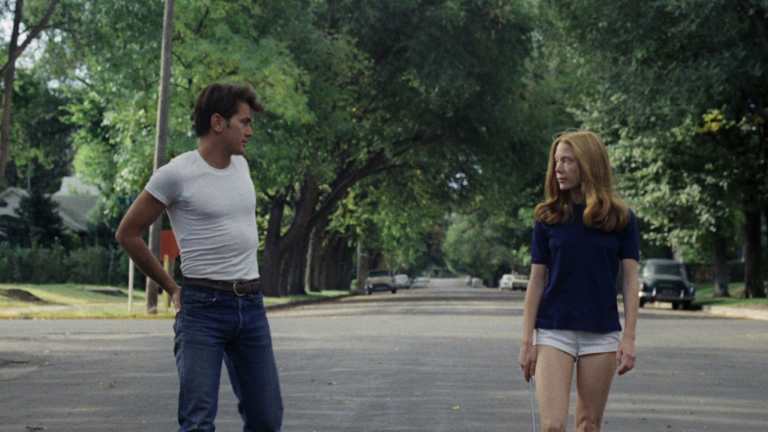
Between December 1957 and January 1958, a young greaser named Charles Starkweather and his girlfriend Caril Ann Fugate went on a murder spree across the frozen Plains of Nebraska and Wyoming, terrorizing the nation and killing 11 in the process. Badlands is a very loose adaptation of these true events by director Terrence Malick. Martin Sheen portrays Kit, a 25-year-old Korean War veteran who seduces 15-year-old Holly, played by Sissy Spacek. He takes her on a killing rampage across the badlands. Esquire writes, “One of many great films about a young couple escaping onto the back roads of free America, Badlands is Bonnie and Clyde with more style, a better script and way more blunt psychopathy.”
The Texas Chain Saw Massacre (1974)
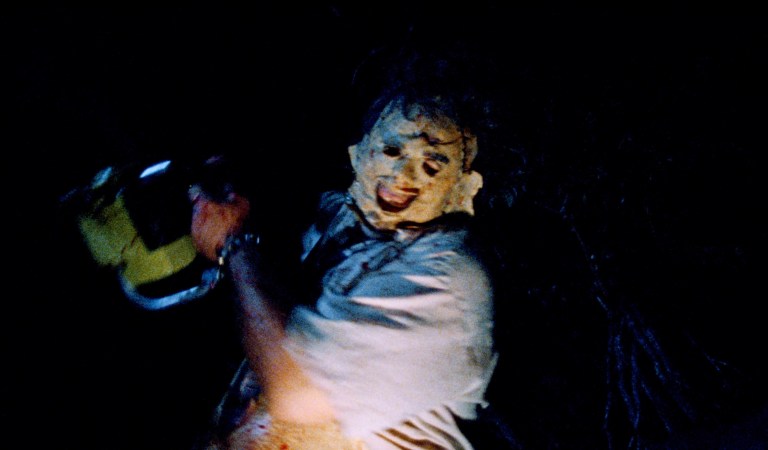
Tobe Hooper’s grisly little masterpiece initially sent shockwaves through American audiences, which is a quaint notion in retrospect when one realizes that there’s really not that much explicit gore in this film. Most of its horror is wrought purely by suggestion. The plot involves a group of friends who take a road trip into rural Texas to visit the grave of one of their grandfathers. When they arrive at what appears to be an abandoned house, they only wind up wishing that it had been abandoned. The character of Leatherface—a giant chainsaw-wielding killer with a mask fashioned from human skin—was said to be based on Wisconsin murderer Ed Gein. Esquire writes, “Tobe Hooper’s foundational cult classic codified the tropes for the tsunami of cheap, straight-to-video horror flicks that would arrive in the coming decade….Made on a tiny budget, its power is in its vérité style and lulling rhythms which suddenly jerk you from atmospheric road movie to quasi-occult chiller riddled with post-Watergate paranoia and mistrust.”
The Town That Dreaded Sundown (1976)
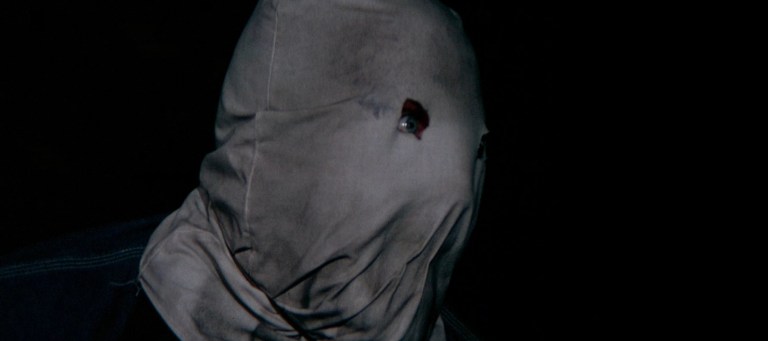
The Town That Dreaded Sundown is inspired by a series of unsolved murders that occurred in and near the Texarkana region of Texas and Arkansas in 1946. In the movie, a hooded man known as the Phantom Killer strikes fear into the town of Texarkana, Arkansas. A Texas Ranger leads the hunt for the murderer, but the trail of the Phantom is difficult to follow since he is rarely seen by anyone who remains alive to tell about about him.
Halloween (1978)

The first of the big films that would become slasher-movie franchises in the 1980s alongside A Nightmare on Elm Street and Friday the 13th, John Carpenter’s Halloween is often considered the perfect distillation of all the tropes that would later distinguish (and, some would say, bog down) the genre. The character of Michael Myers (referred to only as “The Shape” in the credits) would become the embodiment of evil, killing ruthlessly and recklessly and for no apparent reason at all. The original film would lead to a flurry of sequels, prequels, and remakes. The only real constant throughout the franchise is that Michael Myers is going to kill Laurie Strode (Jamie Lee Curtis) no matter how long it takes. Critic Jim Vorel writes, “It’s a lean, mean movie with some absurd characterization in its first half (particularly from the ditzy P.J. Soles, who can’t stop saying ‘totally’) that then morphs into a claustrophobic crescendo of tension as Jamie Lee Curtis’ Laurie Strode first comes into contact with Myers.”
Henry: Portrait of a Serial Killer (1986)
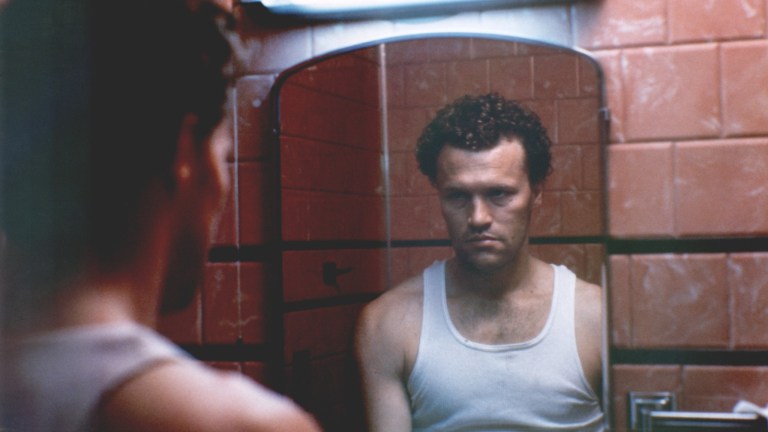
Based loosely on the real-life serial-killing team of Henry Lee Lucas and Otis Toole—Lucas once confessed to killing up to 300 people—this low-budget thriller by John McNaughton places Henry (Michael Rooker) and Otis (Tom Towles) in Chicago, where they film themselves murdering local prostitutes. The film was so dismally gory and such an unflinching gaze into the heart of darkness that it originally received an “X” rating (the modern equivalent is an NC-17), effectively killing its marketability. Critic Tom Nicholson writes, “Less of a psychological or smart thriller than an instrument for blunt trauma, it’s the nihilism and pointlessness of Henry’s killings that make it so disturbing. The idea that someone could murder you just because they feel like it.”
The Hitcher (1986)

C. Thomas Howell stars as Jim Halsey, a young man who is driving someone else’s car from Chicago to San Diego when he picks up a glowering, Nordic-looking hitchhiker named John Ryder (Rutger Hauer). It turns out that Ryder is a serial killer, and his latest target is the poor young sap who decided it would be a good idea to pick him up hitchhiking. Ryder stalks and terrorizes Halsey relentlessly to the point where he breaks Halsey’s mind. Paste writes, “In horror films, there’s something alluring to a relentless and unstoppable killer whose motivation is only to destroy innocent life with nihilistic, almost supernatural fervor….Transform the truck from Duel into Rutger Hauer, and you get The Hitcher.” The film was remade in 2007 with Sean Bean taking up Rutger Hauer’s role.
The Silence of the Lambs (1991)

In nearly 100 years of Academy Awards ceremonies, only three films have won the “Top 5” awards—Best Picture, Director, Actor, Actress, and Screenplay. The first two were 1934’s It Happened One Night and 1975’s One Flew Over the Cuckoo’s Nest. The third was Jonathan Demme’s The Silence of the Lambs, in which aspirant FBI detective Clarice Starling (Jodie Foster) seeks the counsel of sadistic but brilliant convicted serial killer Hannibal Lecter (Anthony Hopkins) for advice in finding a serial killer called “Buffalo Bill” (Ted Levine), who wears his victims’ skin as a mask. It is widely thought that the inspiration for Levine’s character was, as with Psycho and The Texas Chain Saw Massacre, Wisconsin killer Ed Gein. With only 16 minutes of on-screen time, Hopkins won the Best Actor statuette due to the chilling intensity of his performance.
Natural Born Killers (1994)
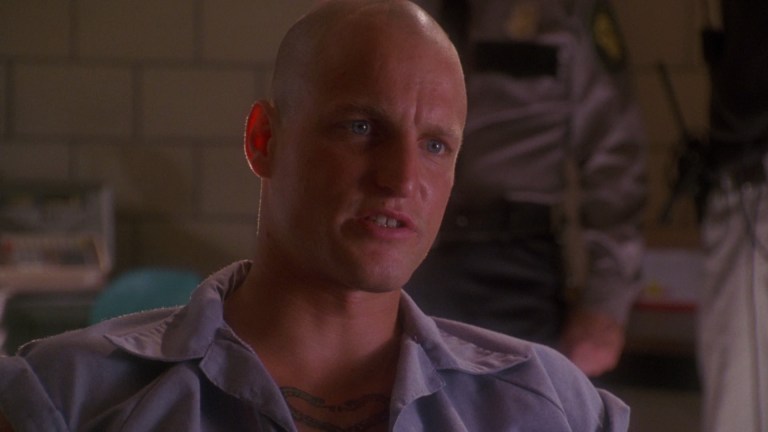
In this violently phantasmagorical fantasy by screenwriter Quentin Tarantino and director Oliver Stone, a male/female serial-killing team a la Starkweather and Fugate named Mickey (Woody Harrelson) and Mallory (Juliette Phillips) rebel against their abusive upbringings by murdering Mallory’s parents, then taking to the road to kill more people. The more media attention they get, the more excited they get. Oliver Stone rejected accusations that his film was intended to glorify violence; instead, he said it was a dark satire on how modern American media turns the most despicable characters into heroes. Roger Ebert writes, “We are becoming a society more interested in crime and scandal than in anything else….Once we were shocked that the Romans threw Christians to the lions. Now we figure out a way to recycle the format into a TV show. That’s what Natural Born Killers is all about.”
Se7en (1995)
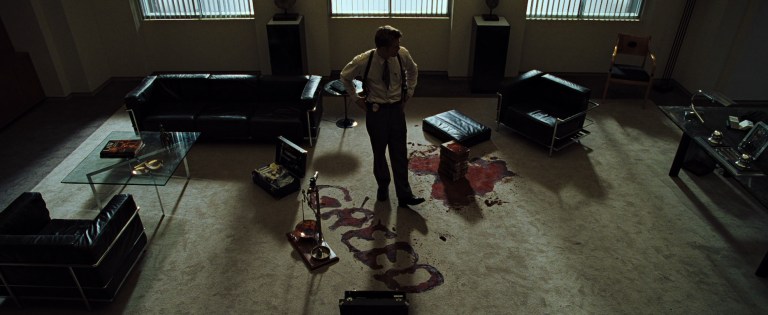
Across a grim, rain-soaked backdrop in an unnamed urban center, two police detectives—enthusiastic rookie David Mills (Brad Pitt) and jaded veteran William Somerset (Morgan Freeman)—attempt to find a serial killer. Known only as “John Doe,” the killer is apparently targeting people based on their egregious transgression of the Seven Deadly Sins. For example, one obese victim is presumed to have been killed for committing the sin of Gluttony, while a Wall Street maven gets murdered for having committed Greed. Toward the film’s end, the killer is unveiled, and he lectures the two detectives not only about sin, but about their own ineptitude. Roger Ebert writes, “Se7en, a dark, grisly, horrifying and intelligent thriller, may be too disturbing for many people, I imagine, although if you can bear to watch it, you will see filmmaking of a high order.”
Scream (1996)
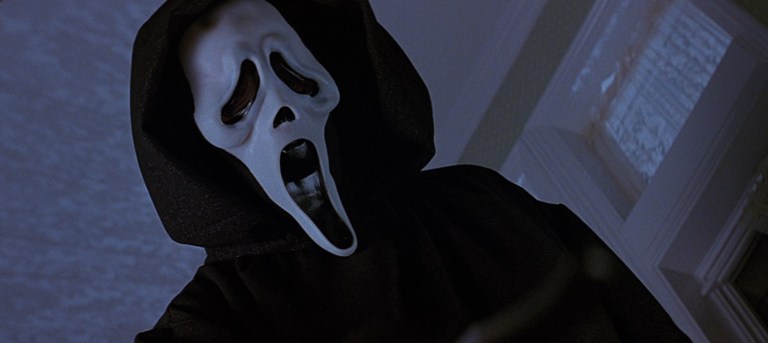
Although director Wes Craven made his name in the early 1980s by riding the “dead teenager” wave of horror, he came back in the mid-90s with an astute and cutting satire of the entire genre. With the “Ghost Face” killer as the masked murderer, Scream lampoons all of the familiar horror tropes—don’t drink, do drugs, have sex, and definitely never say, “I’ll be right back.” If you do any of these things, you’ll be killed. An all-star cast includes Drew Barrymore, Courteney Cox, Neve Campbell, David Arquette, and Rose McGowan. Time Out writes, “Scream is, of course, a meta-commentary on slasher film clichés, but it’s a tremendous slasher film on its own–the opening scene alone is one of the best in the genre’s entire history–and two decades of bad sequels haven’t diluted its place in pop culture.”
American Psycho (2000)
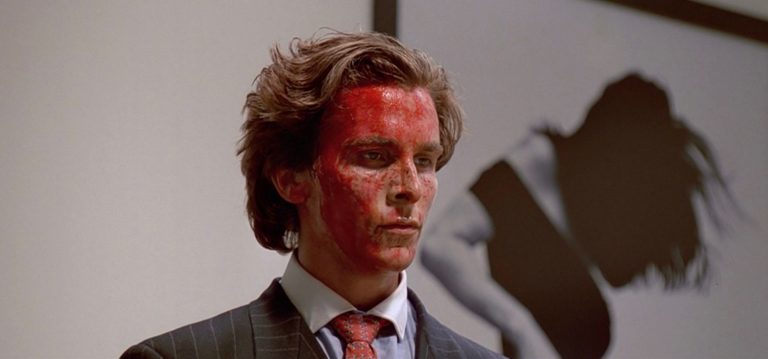
In this film adaptation of Bret Easton Ellis’s novel about a narcissistic yuppie serial killer, Christian Bale plays Patrick Bateman, a young Wall Street executive who is absolutely obsessed with social status and consumerism. When he isn’t fretting over the minutiae of clothes, restaurants, business cards, and bank accounts, he’s hacking people to death. He very carefully rides the line between outward displays of success and inward manifestations of depravity. Time Out calls the film “a provocative socio-psychological satire balanced tantalizingly on the cusp of chilly horror and outrageous comedy. Bateman may be the (barely) human face of a particularly ’80s brand of narcissism and materialist vacuity, but he’s also a spoilt dork without cause or taste.”
Monster (2004)

Aileen Wuornos is often referred to as “the first female serial killer,” which is an outright falsehood. Women have been murdering for centuries, but their preferred route is usually poisoning. Wuornos was unusual in her modus operandi—she was a Florida prostitute who felt driven to kill after too many unpleasant and abusive encounters with her clients. She shot seven men to death before finally being brought to justice and executed. Actress Charlize Theron won an Oscar for her performance as Wuornos in which she underwent a staggering transformation both physically and in terms of personality. A review in Time Out says, “Charlize Theron didn’t just ‘glam down’ to play real-life prostitute turned killer Aileen Wuornos in Patty Jenkins’ unnerving psychological drama–she almost seems to have crawled inside Wuornos’s skin.”
The Girl with the Dragon Tattoo (2011)
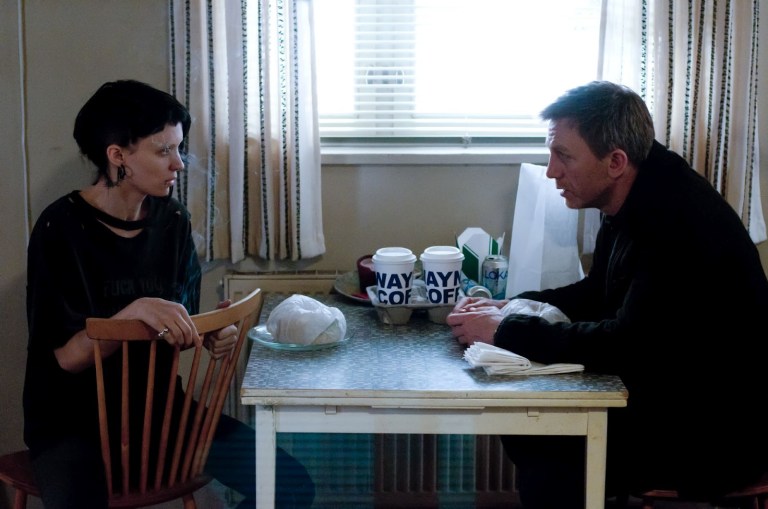
A mystery thriller about a recently disgraced journalist, Mikael (Daniel Craig), who is hired by a wealthy businessman to write a biography about his family as a cover for investigating the disappearance of his grand niece 40 years ago. Mikael gets help from a gifted hacker named Lizbeth (Rooney Mara). The duo uncovers the truth behind the disappearance which involves not one but two serial killers.
The Snowtown Murders (2012)
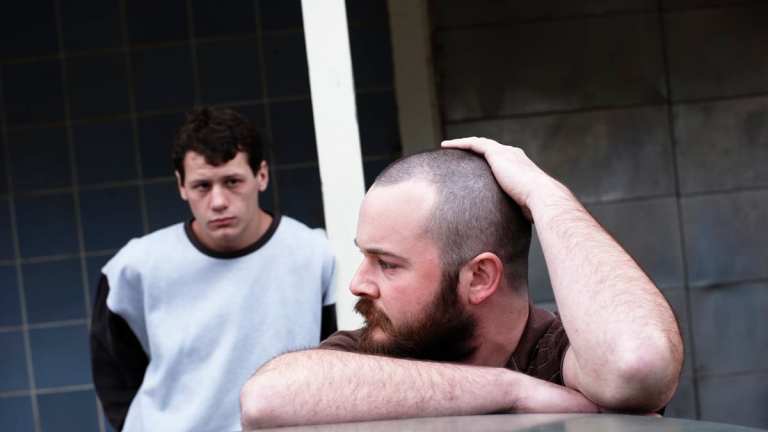
Based on the true story of Australian serial killer John Bunting, who received 11 consecutive life sentences for 11 murders, this film is set in South Australia in the 1990s and is about a family of young brothers who live with their single mom. One day a man named John shows up and assumes the role of the family father. John is bigoted in many ways—he dislikes gays, drug addicts, and the overweight—but he at least temporarily gives the family a sense of stability they’d never had before. Young Jamie, one of the brothers, takes a special liking to Bunting, as he rescued him from molestation not only by a neighbor but by his own brother. But when people in their circle start disappearing, Jamie slowly realizes to his horror that John may not be the Good Samaritan they’d all hoped he was. Roger Ebert writes, “The film is a chilling study of an evil, dominant personality and his victims. It works primarily through an astonishingly good performance by Daniel Henshall as Bunting….The Snowtown Murders is distressing and almost unbearably painful, the most frightening film about a psychopath I’ve seen. There is no way to understand John Bunting. He is quite bluntly an evil man.”
My Friend Dahmer (2017)

For better or worse, Jeffrey Dahmer was the last American “superstar” serial killer, garnering massive press in the early 1990s after killing 17 men and boys and doing unspeakable things with their body parts. This film, based on the autobiographical graphic novel by Derf Backderf—who attended high school with Dahmer—chooses not to focus on the killer’s infamous crimes but rather the strange specter of a mostly lonely dork who’s known for acting “crazy” in school to get laughs slowly transforming into one of the most infamous killers in American history. The Austin Chronicle writes, “Cut out the black shadow of real murders, and My Friend Dahmer is a coming-of-age story about an awkward kid from a dysfunctional family. Oddly, it’s got far more in common with Dazed and Confused than it does with Zodiac.”
The Clovehitch Killer (2018)

In a film that is very loosely based on the real-life story of Dennis Rader—AKA the bland-looking Middle American family man who lived a secret life as the “BTK” killer for “Bind, Torture, Kill”—a family patriarch named Don (Dylan McDermott) is a Scout leader and an inspiration to his young son Tyler (Charlie Plummer) until Tyler starts to suspect that his dad is responsible for the piles of corpses that start showing up around town. Noting how the idea of a seemingly normal man being a serial killer can be more unsettling than the usual horror tropes, The Artful Critic writes, “Evil hiding in a picturesque Bible Belt town can be much more disturbing and frightening than a masked killer with a butcher knife in plain sight.”
The Good Nurse (2022)

Jessica Chastain stars as Amy Loughren, a single mother with a life-threatening heart condition who takes a job as an ICU nurse hoping to stay alive long enough to start receiving free healthcare through her job. When a male nurse named Charles Cullen (Eddie Redmayne) arrives, he seems eager—perhaps too eager—to help Jessica with all of her troubles. But simultaneous with Charles’s arrival is a sudden spike in deaths among patients in the ICU. When she notices that two of the patients in Charles’s direct care have died, she cautiously approaches police and asks them to investigate. The film is based on a true story detailed in the 2014 book, The Good Nurse: A True Story of Medicine, Madness, and Murder.
Pearl (2022)
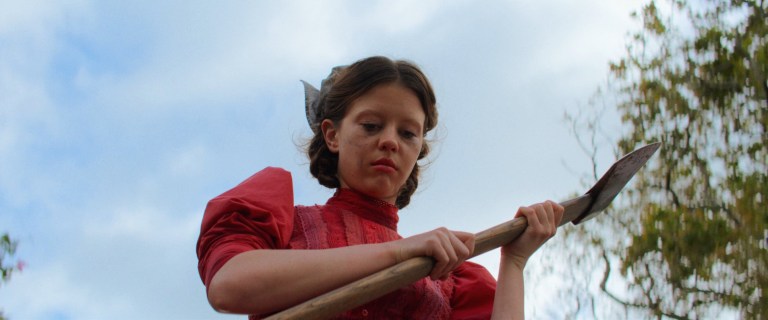
Set in 1918, Pearl tells the story of how Pearl (Mia Goth), the daughter of German immigrants living in the Texas countryside, became the serial killer we first saw in the film X (2022). The darkness dwelling inside Pearl spills out more and more as the movie progresses, giving viewers a clear and disturbing look into the origins of a killer.
Longlegs (2024)
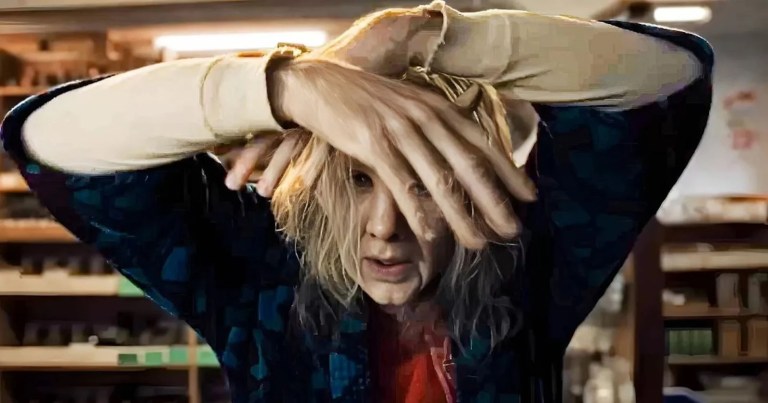
New FBI agent Lee Harker (Maika Monroe) investigates the identity of a prolific serial killer called Longlegs. For decades, Longlegs has claimed responsibility for a string of familicides in letters coded with Satanic symbols. Longlegs sends Harker a letter of her own and she begins to realize her own childhood may contain a clue about his identity.
Red Rooms (2024)
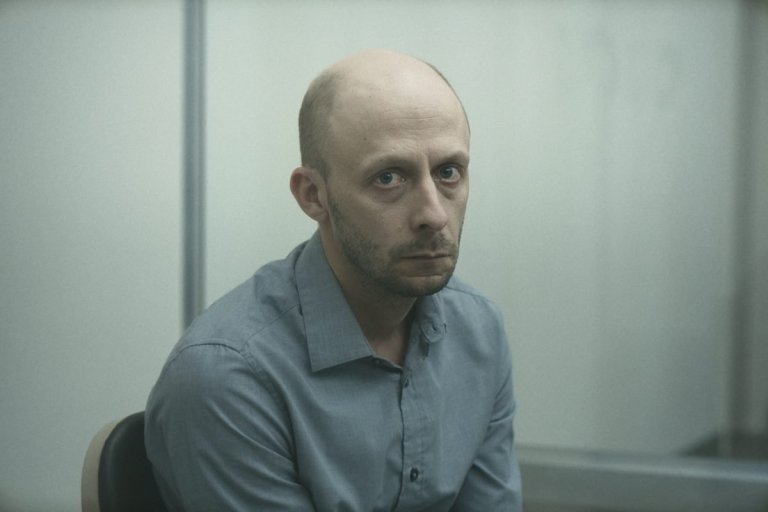
A Canadian (French language) psychological thriller about a highly publicized trial for a man accused of torturing and murdering three young girls and broadcasting the crimes on “red rooms” on the dark web. Model Kelly-Anne (Juliette Gariépy) is so obsessed with the case that she sleeps on the street in order to ensure she is one of the few members of the public allowed to view the trial. Her obsession begins to impact her real life as the prosecutors struggle to prove the man’s guilt.
Strange Darling (2024)

A serial killer has been terrorizing rural Oregon and the film’s prologue notes that we are about the see the killer’s final crimes. A man (Kyle Gallner) and a woman (Willa Fitzgerald) flirt in a car and contemplate having a one night stand. As they enter a motel room, things gradually shift and turn into a cat and mouse chase.
Trap (2024)
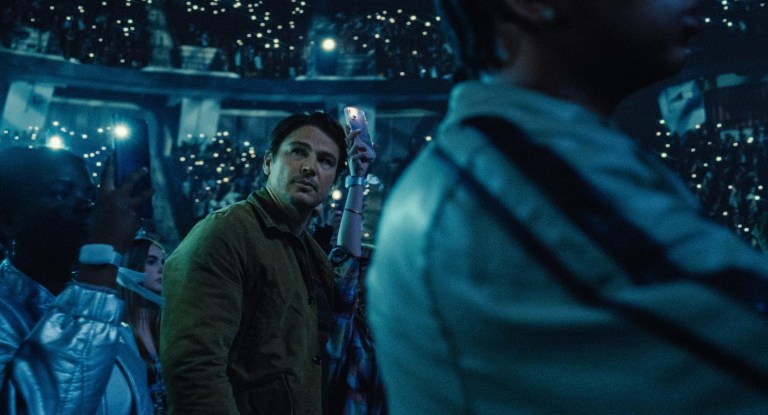
Josh Hartnett portrays a serial killer named Cooper who is known as “The Butcher” for dismembering his victims. While at a concert with his daughter, Cooper discovers he has been caught in a trap — the police know that The Butcher is at the concert and are interviewing every man who meets the profile before they can exit the area. The audience follows Cooper as he tries to find a way to escape, something he proves to be pretty adept at.
Woman of the Hour (2024)
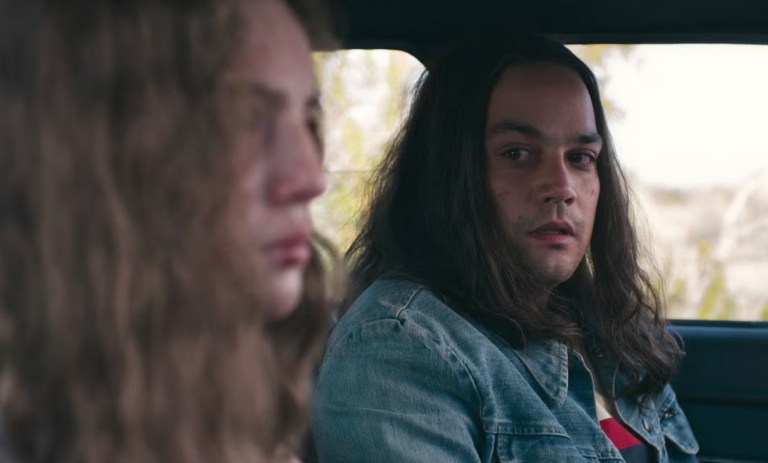
A crime thriller directed by Anna Kendrick in her debut, Woman of the Hour fictionalizes several women’s stories about encountering serial killer Rodney Alcala. Kendrick portrays Sheryl, an aspiring actress who goes on the game show The Dating Game, where she meets Alcala as “Bachelor #3”. Like the real life story, despite selecting Alcala as the winner, Sheryl declines to go on the “prize” date with him because of his creepy behavior.
More Serial Killer Movies

- The Cabinet of Dr. Caligari (1920) this silent classic of German Expressionism features a sinister hypnotist who trains a sleepwalker to be a serial killer.
- The Lodger: A Story of the London Fog (1926) is Alfred Hitchcock’s third silent film and the one that established him as a director to be reckoned with. A young man takes up residence in a London boarding house just as a serial killer the press calls the “Avenger” begins killing blonde women.
- M (1931) is Fritz Lang’s masterpiece about a depraved child murderer (Peter Lorre) who is brought to justice by the criminal underworld because the local police prove to be too inept to solve the case.
- Arsenic and Old Lace (1944) is director Frank Capra’s adaptation of a dark Broadway comedy about a serial poisoner.
- Deep Red (1975) Dario Argento’s most famous and influential giallo film stars David Hemmings as a teacher who attempts to solve a serial murder case.
- Cruising (1980) directed by William Friedkin of The Exorcist and The French Connection fame, this dark procedural drama stars Al Pacino as a New York cop who gets drawn into the local gay leather underworld to help find a serial killer.
- Serial Mom (1994) is John Waters’s comedic homage to the genre about a wholesome-looking mom (Kathleen Turner) with a wicked lust for vengeance.
- Summer of Sam (1999) Spike Lee’s movie is set in 1977 when David “Son of Sam” Berkowitz terrorized New York City with a string of nighttime attacks on residents.
- Hannibal (2001) Anthony Hopkins reprises his award-winning role of Dr. Hannibal Lecter that he immortalized in The Silence of the Lambs.
- Perfume: The Story of a Murderer (2006) is set in France during the 1700s and centers around a depraved killer who slays women and tries to capture their “essence” through perfume.
- Zodiac (2007) is about the hunt for the infamous Zodiac Killer, starring a remarkable cast including Jake Gyllenhaal, Mark Ruffalo, and Robert Downey Jr.
- God Bless America (2011) Bobcat Goldthwait’s dark satire features two people who’ve been pushed to the end of their patience and start randomly murdering people.
- Maniac (2012) Based on the slasher classic of the same name from 1980, Maniac puts viewers in the head of a serial killer by presenting the movie from the first-person perspective of killer Frank Zito (Elijah Wood).
- The House That Jack Built (2018) Matt Dillon stars as a killer who looks back the the horrific crimes he committed throughout his time as a murderer.
- Barbarian (2022) has a lot going on, but the plot is set in motion decades ago by a serial killer played by Richard Brake.
- Piggy (2022) a bullied overweight teenager’s life changes when she meets a serial killer on the walk home from from a local swimming hole.
